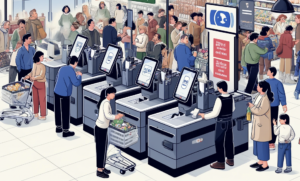Self-Checkout Systems: a shift back to traditional methods?
In recent years, self-checkout systems have become increasingly common in Hungary, though they have received mixed reactions from shoppers. While these systems have been in place in more developed countries for some time, some of these countries are now reverting to traditional cashier-operated checkouts due to a significant rise in shoplifting associated with automation.
The Spread and Challenges of Self-Checkout Systems
 In a busy discount store in Budapest, long queues form as only one cashier is available while the rest are self-checkout stations. An attendant is present to assist those unfamiliar with the new system and to ensure all items are scanned correctly. Many shoppers still prefer the traditional checkout method, struggling with the self-checkout process and the fact that only card payments are accepted.
In a busy discount store in Budapest, long queues form as only one cashier is available while the rest are self-checkout stations. An attendant is present to assist those unfamiliar with the new system and to ensure all items are scanned correctly. Many shoppers still prefer the traditional checkout method, struggling with the self-checkout process and the fact that only card payments are accepted.
Shoppers using traditional checkouts also face new challenges, such as needing to scan their receipt at an exit kiosk to confirm payment. This system was introduced in busy stores to manage high foot traffic, particularly from tourists.
The Role of Cashiers in Retail
When self-checkout systems were first introduced, there were concerns about increased shoplifting. Initially, thefts did rise slightly, but over time, self-checkouts became the norm, supported by security guards. As the number of in-store employees decreased, cashiers became central to the retail system, often multitasking when not attending to customers.
In Hungary, fully automated stores have also appeared, similar to those in Japan. Self-checkout is becoming common in drugstores, where customers often seek assistance or information about products, which busy staff cannot always provide.
International Experiences: Returning to Traditional Checkouts
In some countries, such as Sweden and Australia, stores are reverting to traditional checkouts. The anticipated speed and efficiency gains from self-checkout systems have not materialized, and shoplifting has surged. Automated systems cannot monitor what shoppers place in their bags, and it’s impractical to place security tags on all items, especially inexpensive ones.
For instance, the Australian retail chain IGA Greenslopes abandoned self-checkouts due to a significant rise in theft, despite implementing various security measures. Similarly, the UK’s Booths supermarket chain decided to remove self-checkouts, countering the trend of increased investment in these systems by many food retailers.
Workforce Shortages and Resistance to Automation
In Hungary, social media is rife with criticism of self-checkout systems, with users complaining about having to perform cashier duties themselves amidst high inflation and expensive food prices. This sentiment echoes the resistance to automation seen during the Industrial Revolution, where people feared machines would take their jobs. Today, the issue is compounded by labor shortages, forcing stores to adopt machines despite a growing and overwhelming product selection.
Ultimately, self-checkout systems have not resolved issues related to workforce shortages and shoplifting. This has led some retailers to reconsider the extent of automation and the role of traditional cashiers in their operations.
Related news
Related news
New EU tariffs could arrive in 2026 – this is how they could transform the market
🎧 Hallgasd a cikket: Lejátszás Szünet Folytatás Leállítás Nyelv: Auto…
Read more >NMHH warns of the risks of online marketplaces
🎧 Hallgasd a cikket: Lejátszás Szünet Folytatás Leállítás Nyelv: Auto…
Read more >Allegro opened the Central European market to Hungarian businesses
🎧 Hallgasd a cikket: Lejátszás Szünet Folytatás Leállítás Nyelv: Auto…
Read more >




